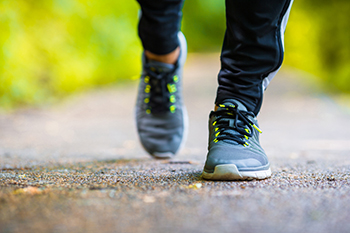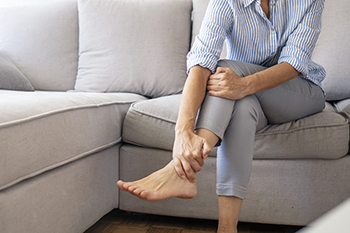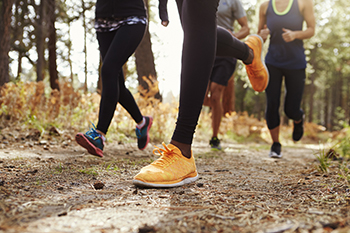Connect With Us
Blog
Items filtered by date: October 2023
Causes and Treatment for Foot Drop

Foot drop, a condition that affects one foot and impedes the ability to walk normally, can stem from various causes. Most commonly, foot drop results from peroneal nerve injury, often linked to sports injuries or surgical incidents, like hip or knee replacements. Spinal problems, such as slipped discs, may also compress the peroneal nerve, as can prolonged leg crossing, kneeling, or squatting. Peripheral neuropathy from diabetes can damage nerves and weaken muscles, potentially leading to foot drop. Extended immobility, such as hospital stays, can cause muscle weakness, including those governing foot movement. The main symptom of foot drop is a marching gait that requires a higher lifting of the knee with each step to allow the toe to clear the ground. Addressing foot drop can involve customized exercise regimens to strengthen and stretch leg and foot muscles. Devices, including braces, splints, or shoe inserts may help to promote foot stability and reduce fall risks. Electrical nerve stimulation aids nerve activation, which may be beneficial for stroke or multiple sclerosis patients. Surgery may be considered in cases of permanent foot drop, involving joint fusion for stability or nerve repair and grafting to restore function. For a clear idea of how to manage foot drop, it is suggested that you make an appointment with a podiatrist.
If you have any concerns about your feet, contact one of our podiatrists from New England Foot and Ankle. Our doctors can provide the care you need to keep you pain-free and on your feet.
Biomechanics in Podiatry
Podiatric biomechanics is a particular sector of specialty podiatry with licensed practitioners who are trained to diagnose and treat conditions affecting the foot, ankle and lower leg. Biomechanics deals with the forces that act against the body, causing an interference with the biological structures. It focuses on the movement of the ankle, the foot and the forces that interact with them.
A History of Biomechanics
- Biomechanics dates back to the BC era in Egypt where evidence of professional foot care has been recorded.
- In 1974, biomechanics gained a higher profile from the studies of Merton Root, who claimed that by changing or controlling the forces between the ankle and the foot, corrections or conditions could be implemented to gain strength and coordination in the area.
Modern technological improvements are based on past theories and therapeutic processes that provide a better understanding of podiatric concepts for biomechanics. Computers can provide accurate information about the forces and patterns of the feet and lower legs.
Understanding biomechanics of the feet can help improve and eliminate pain, stopping further stress to the foot.
If you have any questions please feel free to contact one of our offices located in Chelmsford and Newburyport, MA . We offer the newest diagnostic and treatment technologies for all your foot and ankle needs.
Are You Suffering From Ingrown Toenails?
Can Orthotics Help With Bunions?

A bunion, known medically as hallux valgus, is a bony deformity affecting the joint at the base of the big toe. This condition is characterized by the big toe angling outward towards the other smaller toes on the same foot. This deviation from the toe's natural alignment can lead to discomfort and pain, especially as it progresses. Bunions can manifest with various symptoms and associated issues. These may include pain, swelling, numbness, a burning sensation, or tingling around the bunion area. Footwear can exacerbate these symptoms, leading to discomfort. Additionally, hard, calloused, red, or painful skin may develop over the top of the bunion. Mobility can be restricted, with the big toe being particularly painful to move up and down. Bunions can also contribute to the development of hammertoes, corns, and calluses on the ball of the foot. These conditions can affect one's gait, causing instability while walking. Finding appropriate and comfortable shoes can become challenging due to the deformity and pain associated with bunions, further impacting daily activities and comfort. Orthotics cannot correct a bunion, but they can help with reducing pain in the big toe joint and slow its progression. Conditions such as flat feet can put more pressure on your bunion and wearing orthotics can redistribute that pressure. If you are experiencing pain from your bunion when walking or exercising, it is suggested that you make an appointment with a podiatrist to discuss the use of custom-made orthotics for increased comfort and function.
If you are suffering from bunions, contact one of our podiatrists of New England Foot and Ankle. Our doctors can provide the care you need to keep you pain-free and on your feet.
What Is a Bunion?
A bunion is formed of swollen tissue or an enlargement of boney growth, usually located at the base joint of the toe that connects to the foot. The swelling occurs due to the bones in the big toe shifting inward, which impacts the other toes of the foot. This causes the area around the base of the big toe to become inflamed and painful.
Why Do Bunions Form?
Genetics – Susceptibility to bunions are often hereditary
Stress on the feet – Poorly fitted and uncomfortable footwear that places stress on feet, such as heels, can worsen existing bunions
How Are Bunions Diagnosed?
Doctors often perform two tests – blood tests and x-rays – when trying to diagnose bunions, especially in the early stages of development. Blood tests help determine if the foot pain is being caused by something else, such as arthritis, while x-rays provide a clear picture of your bone structure to your doctor.
How Are Bunions Treated?
- Refrain from wearing heels or similar shoes that cause discomfort
- Select wider shoes that can provide more comfort and reduce pain
- Anti-inflammatory and pain management drugs
- Orthotics or foot inserts
- Surgery
If you have any questions, please feel free to contact one of our offices located in Chelmsford and Newburyport, MA . We offer the newest diagnostic and treatment technologies for all your foot care needs.
Different Types of Foot Arthritis

Arthritis is characterized by inflammation in one or more joints, leading to pain and stiffness. It is prevalent in the small joints of the foot and ankle, impacting mobility and daily activities. While there is no cure for arthritis, treatment options can help manage symptoms and slow disease progression. The foot and ankle play vital roles in supporting, balancing, and absorbing shock during activities. These areas contain multiple joints and are susceptible to various forms of arthritis like osteoarthritis, rheumatoid arthritis, and gout. Osteoarthritis gradually erodes joint cartilage, causing pain, stiffness, and bone spurs. Risk factors include age, obesity, genetics, and poor foot alignment. Rheumatoid arthritis is a chronic autoimmune disease that can start in the foot and ankle, leading to joint inflammation, swelling, and deformity. Genetic and environmental factors can trigger this condition. Gout is a painful inflammation that often affects the big toe joint due to the accumulation of uric acid crystals. It can lead to sudden and severe joint pain. If you have foot or ankle discomfort from arthritis, it is suggested that you make an appointment with a podiatrist to determine which kind of arthritis is affecting you.
Arthritis can be a difficult condition to live with. If you are seeking treatment, contact one of our podiatrists from New England Foot and Ankle. Our doctors can provide the care you need to keep you pain-free and on your feet.
Arthritic Foot Care
Arthritis is a term that is commonly used to describe joint pain. The condition itself can occur to anyone of any age, race, or gender, and there are over 100 types of it. Nevertheless, arthritis is more commonly found in women compared to men, and it is also more prevalent in those who are overweight. The causes of arthritis vary depending on which type of arthritis you have. Osteoarthritis for example, is often caused by injury, while rheumatoid arthritis is caused by a misdirected immune system.
Symptoms
- Swelling
- Pain
- Stiffness
- Decreased Range of Motion
Arthritic symptoms range in severity, and they may come and go. Some symptoms stay the same for several years but could potentially get worse with time. Severe cases of arthritis can prevent its sufferers from performing daily activities and make walking difficult.
Risk Factors
- Occupation – Occupations requiring repetitive knee movements have been linked to osteoarthritis
- Obesity – Excess weight can contribute to osteoarthritis development
- Infection – Microbial agents can infect the joints and trigger arthritis
- Joint Injuries – Damage to joints may lead to osteoarthritis
- Age – Risk increases with age
- Gender –Most types are more common in women
- Genetics – Arthritis can be hereditary
If you suspect your arthritis is affecting your feet, it is crucial that you see a podiatrist immediately. Your doctor will be able to address your specific case and help you decide which treatment method is best for you.
If you have any questions, please feel free to contact one of our offices located in Chelmsford and Newburyport, MA . We offer the newest diagnostic and treatment technologies for all your foot care needs.
Dealing With Swollen Feet While Pregnant

One discomfort that often accompanies pregnancy is swollen ankles, known as edema. Fortunately, there are several ways to minimize the problem. The key to managing swollen ankles during pregnancy is to defy gravity. Sit with your feet elevated to reduce pressure on the lower extremities. While seated, circle your ankles occasionally to encourage blood flow, and avoid standing for extended periods. Sleeping on your left side is believed to be beneficial for your baby and for your circulation. This position alleviates pressure on the inferior vena cava, helping to reduce ankle swelling. Elevating your legs at a gentle angle with pillows can further promote healthy blood flow. Consider investing in compression stockings to prevent blood from pooling in your ankles. Incorporate daily gentle exercises into your routine, such as swimming and walking. These activities help keep your blood flowing optimally, reducing the risk of swollen ankles. If you have concerns about swollen ankles or any other foot-related issues during pregnancy, it is suggested that you consult a podiatrist for an evaluation and recommended treatment options.
Pregnant women with swollen feet can be treated with a variety of different methods that are readily available. For more information about other cures for swollen feet during pregnancy, consult with one of our podiatrists from New England Foot and Ankle. Our doctors will attend to all of your foot and ankle needs.
What Foot Problems Can Arise During Pregnancy?
One problem that can occur is overpronation, which occurs when the arch of the foot flattens and tends to roll inward. This can cause pain and discomfort in your heels while you’re walking or even just standing up, trying to support your baby.
Another problem is edema, or swelling in the extremities. This often affects the feet during pregnancy but tends to occur in the later stages.
How Can I Keep My Feet Healthy During Pregnancy?
- Wearing orthotics can provide extra support for the feet and help distribute weight evenly
- Minimize the amount of time spent walking barefoot
- Wear shoes with good arch support
- Wear shoes that allow for good circulation to the feet
- Elevate feet if you experience swelling
- Massage your feet
- Get regular, light exercise, such as walking, to promote blood circulation to the feet
If you have any questions please feel free to contact one of our offices located in Chelmsford and Newburyport, MA . We offer the newest diagnostic and treatment technologies for all your foot and ankle needs.
Do Your Child's Feet Hurt?
Features of Trail Running Shoes

When it comes to trail running, selecting the ideal footwear is of the utmost importance. Trail running shoes are purpose-built to tackle uneven terrain, rocky paths, and unpredictable weather. To ensure a comfortable and injury-free experience, focus on these key aspects while shopping for trail running shoes. Traction is paramount. Seek out shoes with aggressive outsoles that provide superior grip on various surfaces, from muddy tracks to rocky trails. For stability, opt for shoes that offer robust ankle support to prevent sprains and injuries on uneven ground. Cushioning is another essential consideration. Strike a balance between cushioning and responsiveness to safeguard your feet without sacrificing agility. A proper fit is equally critical. Choose shoes that offer a snug fit with enough room for your toes to prevent blisters and ensure a secure stride. Durability is another important consideration. Choose footwear made from top-quality materials and breathable uppers that can withstand the rigors of trail running. For more help with choosing footwear for trail running, it is suggested that you make an appointment with a podiatrist for personalized advice based on your unique foot structure and running style.
You should always make sure your running shoes fit properly in order to avoid injury. For more information, contact one of our podiatrists from New England Foot and Ankle. Our doctors can provide the care you need to keep you pain-free and on your feet.
Choosing the Right Running Shoe for Your Foot Type
Improper shoe sizing can cause a myriad of problems for your feet. Shoes that don’t fit you properly can lead to muscular imbalances in your body, which can result in foot, knee, and hip injuries.
Tips for Finding the Right Running Shoe
- Make sure you have a thumb’s width of wiggle room between the end of your longest toe and the front of the shoe.
- There should be little to no slipping at the heel
- Don’t assume your size in one shoe brand will be your size in another
- Do not lace up your shoes too tightly
- Walk around in the store with your new shoes before you buy them
If you have any questions please feel free to contact our one of our offices located in Chelmsford and Newburyport, MA . We offer the newest diagnostic and treatment technologies for all your foot and ankle needs.


